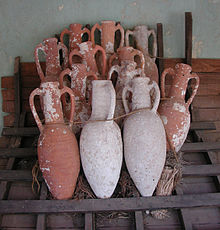Dokos shipwreck

The Dokos shipwreck is the oldest underwater shipwreck discovery known to archeologists.[1] The wreck has been dated to the second Proto-Helladic period, 2700–2200 BC.[2]
The remains of the shipwreck are located about 15–30 meters underwater off the coast of southern Greece near the island of Dokos (ancient name Aperopia) in the Aegean Sea.[3] Dokos island is about 60 miles east of Sparta, Peloponnese.[4]
The ship itself is long gone, as everything biodegradable has been taken back by the sea. The remains at the sea floor of a cargo site of hundreds of clay vases and other ceramic items are evidence of the shipwreck.[1] The four-thousand-year-old ancient shipwreck was discovered by Peter Throckmorton on August 23, 1975.[5][6]
The Dokos wreck site was extensively excavated in 1989–1992 by the Hellenic Institute of Marine Archaeology (HIMA).[7] Archaeologist Dr. George Papathanasopoulos, President of HIMA, conducted this first ever full-scale excavation in Greece of an ancient shipwreck. Due to the irregularity of the seabed, a new system, the Sonic High Accuracy Ranging and Positioning (SHARPS) was used to plot and map the underwater finds. Additional surveys were conducted and the Early Helladic period was confirmed.[8]
Evidence
According to HIMA, the Cycladic pottery evidence is dated to around 2200 BC and the oldest known underwater shipwreck yet discovered.[9] The clay pots appear to be merchandise from an ancient Argolida manufacturing facility.[4] It is guessed that these were intended for trade to small coastal villages around the Gulf of Argos and the Myrtoan Sea. The cargo site consists of one of the largest collections of Early Helladic II pottery known. This Helladic pottery technology was even before the invention of the pottery wheel.[8]
The pottery consisted of hundreds of ceramic pieces including cups, kitchenware, and urns. Over 500 clay vases were uncovered, dating around the Early Helladic period. There were a variety of sauceboats, in multiple shapes and sizes. The bowls and sauce boats of the Early Helladic period were the most common types found in southern and central Greece. After further inspection of the sauceboats, it is suggested that these types resemble those from Askitario in Attica, also comparable to ones in Lerna and from the Cyclades. This evidence shows that the shipwreck may lie on the maritime trade route from South Euboea to the Saronic and Argolid gulfs. There were many amphoras found, as well as basins, wide-mouthed jars, braziers, baking trays, askoi, pithoi, and common household utensils.[10]
Stone anchors were also found 40 meters from the wreck. The anchors consisted of two large boulders with holes drilled in them, likely they would have been dropped before the ship sank.[4] There were also lead ingots used for trade found.[4] The merchant ship had a wide variety of tableware and it is speculated it traded all over the region.[11]
During the 1989 to 1992 HIMA excavation, the site produced more than 15,000 pottery sherds and artifacts. They also found many millstones at the site that is speculated was used as part of the ship's cargo or possibly as ballast. These artifacts and items were raised from the sea bottom and transported to the Spetses Museum. There they will be studied and placed into conservation.[10]
Notes
- ^ a b Anzovin, item 5396, p. 385: The oldest underwater shipwreck known to archeologists is the Dokos wreck, located in waters 60 to 85 feet (18 to 26 meters) deep in the Aegean Sea off the island of Dokos, Greece.
- ^ HomeboyMediaNews – "Attempt to purchase protected island of Dokos", April 17, 2007.
- ^ Hydra News: "Attempts to purchase protected island of Dokos", April 17, 2007 Archived September 8, 2008, at the Wayback Machine.
- ^ a b c d Anastasi, pp. 1–2.
- ^ The Early Helladic Shipwreck (1992) Archived July 24, 2011, at the Wayback Machine.
- ^ Destination Dokos Archived July 21, 2011, at the Wayback Machine
- ^ Dokos Shipwreck Archived July 21, 2011, at the Wayback Machine
- ^ a b Hellenic Institute of Marine Archaeology Archived January 21, 2008, at the Wayback Machine
- ^ Hellenic Institute of Marine Archaeology (HIMA) Archived March 7, 2016, at the Wayback Machine
- ^ a b The Dokos Cargo site
- ^ Engines of Our Ingenuity: A Minoan Wreck by John H. Lienhard
Sources
- Anastasi, P. "Aegean Sea Floor Yields Clues to Early Greek Traders." The New York Times, January 2, 1989.
- Anzovin, Steven et al. Famous First Facts (International Edition), H. W. Wilson Company, 2000, ISBN 0-8242-0958-3
- Enalia Annual 1990, Vol 2 (publ. 1992). HIMA, Athens
- Wachsmann, Shelley. Seagoing Ships & Seamanship in the Bronze Age Levant. College Station: Texas A&M University Press, 1998. Web
Further reading
- A Brief History of Underwater Archaeology in Greece
- Hudson, Kenneth et al. The Book of Shipwrecks. Macmillan, 1979, ISBN 0-333-22092-7
